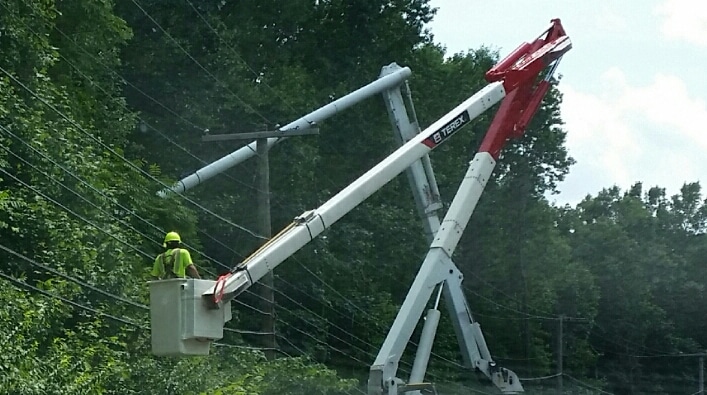Working around power lines can have serious consequences.
Electrical Workers Seriously Injured
Very recently, two PAR Electric employees in Missouri were seriously injured from electric shock as they worked near a 69kV power line. They were holding a pole while a crane was moving into position when a gust of wind blew their pole into the energized line.
Both men were airlifted to different hospitals for treatment.
Tree Trimmer Gets Shocked
Another recent accident involved a 25-year-old tree trimmer who made contact with a 7200V power line with his saw as he was operating a hydraulic lift in St. Petersburg, FL. He remained conscious after the shock and was able to lower the lift to the ground, where responders took him off the platform and he was taken to a burn center.
Farming Accident
Zach Short, a farmer, sustained burn injuries over 54% of his body after his grain cart contacted a live 7200V power line in 2014. He survived, but he lost both legs, the left one amputated above the knee. He uses prosthetic legs to walk and has had tendon transfer surgery to be able to use his left hand again.
Short is able to work now, but he takes extra precautions. “Just looking at the burns around my fingers, I can see where I jumped onto the ladder,” he said. “Every time I’m in the field and see a power line, even if it’s a mile away, I’m very, very careful now.”
Preventing This From Happening to You
All of these jobs, as well as others, require work to be done near power lines. And while we know that overhead power lines and any equipment that reaches within a few feet of those lines do not mix, too many injuries and deaths occur because of accidental contact. The good news is that there are preventative measures that can be followed to allow workers to return home at the end of the work day still injury-free.
Standards: Construction Industry
CFR 1926 Subpart K is the standard for work done around electricity for the construction industry. It addresses the hazards of using electricity at jobsites as well as hazards from accidental contact with all energized lines. This includes requirements concerning employee training, how to use a ladder safely, working around an electrical circuit, and providing medical attention if a serious injury occurs.
Standards: Other Industries
CFR 1910.333 talks about standards for workers in other industries. It specifies minimum distances (at least 10 feet) away from energized equipment where workers must be if they are using conductive objects [1910.333(c)(3)(i)(A)]. Don’t use metal ladders when working near power lines. A best practice is to keep all vehicles, objects, and personnel well beyond the OSHA minimum distance. e-Hazard recommends at least 20 feet away.
NIOSH Publication about Ladders around Power Lines
The National Institute for Occupational Safety and Health (NIOSH) has developed recommendations to prevent injuries and deaths while working with metal ladders around power lines.
Even this publication states NOT to use metal ladders around power lines. Among many other recommendations, it advises workers to keep a minimum of 10 feet away from power lines when using conductive objects for lines up to 50kv, increasing that distance by 4 inches for every 10kv of power higher than 50kv.
Ask Questions as a Best Practice
Every day at every job site, step back, survey the whole scene, and ask some pointed questions:
- Are there any power lines near the job area?
- What precautions have been taken?
- Has every possibly dangerous situation been communicated to workers on site?
- Has anything changed since the previous day’s work at that site?
- Are there any new workers to the job who are not familiar with the surroundings?
…and perhaps one of the most important questions used by firefighters and other emergency response personnel is simply, “Is the scene safe?” Asking this simple question will increase awareness of company employees to workplace hazards that otherwise might go unrecognized. These hazards can certainly involve electrical overhead hazards, but also can be things like mobile equipment close to the worksite, pedestrians who “mean well”, overhead suspended loads, or mechanical lines under pressure. These hazards, although not specifically electrical in nature, account for many workplace injuries and fatalities, simply because personnel on the site are not even aware of their existence. Scene safety thinking is the key to making any workplace safer, and even more critical when electrical lines or equipment is in the vicinity.
Reduction in Numbers of Power Line Fatalities
During a 2014 interview, David Wallace, senior electrical engineer with OSHA (now retired), states that the number of fatalities per year due to contact with energized power lines has been reduced significantly because of the development and implementation of best practices begun through a partnership between OSHA and electrical utilities, contractors, and unions. The number of fatalities went from 10 per year to zero for a couple of years. The number increased again, but only slightly (1 or 2 – still too many).
Training on best practices and then implementing them saves lives!
David Wallace’s interview is posted on YouTube.


Pingback: Billboard Electric Shock Accident in California : e-Hazard Blog
It’s helpful that you said the minimum distance is at least 10 feet away so I know how far away to stay from the power lines. I want to trim a tree by my house because it’s pretty dead. I’ll make sure to be safe while I do that.
If there is any doubt, hire a professional. This is one of the ways people get killed along with cleaning the gutters and allowing a metal ladder to hit their service line.